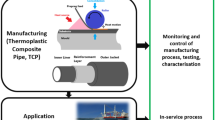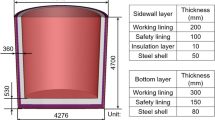Abstract
Welding residual stress is one of the main concerns for fabrication and operation of steel structures due to its potential effect on structural integrity. This paper focuses on the effect of welding residual stress on the ductile crack growth resistance of circumferentially cracked steel pipes. Two-dimensional axi-symmetry model has been used to simulate the pipe. Residual stresses were introduced into the model by using so-called eigenstrain method. The complete Gurson model has been employed to calculate the ductile crack growth resistance. Results show that residual stresses reduce the ductile crack growth resistance. However, the effect of residual stresses on ductile crack growth resistance decreases with the increase of crack growth. The effect of residual stress has also been investigated for cases with different initial void volume fraction, material hardening and crack sizes.
Similar content being viewed by others
References
Sherry A H, Wilkes M A, Sharples J K and Budden P J. The assessment of residual stress effects on ductile tearing using continuum damage mechanics. Journal of Pressure Vessel Technology, 2008. 130(4): 041212-1–041212-8
Liu J, Zhang Z L, Nyhus B. Residual stress induced crack tip constraint. Engineering Fracture Mechanics, 2008, 75(14): 4151–4166
Ren X B, Zhang Z L, Nyhus B. Effect of residual stresses on the crack-tip constraint in a modified boundary layer model. International Journal of Solids and Structures, 2009, 46(13): 2629–2641
Ren X B, Zhang Z L, Nyhus B. Effect of residual stresses on ductile crack growth resistance. Engineering Fracture Mechanics, 2010, 77(8): 1325–1337
Sharples J K, France C C, Ainsworth R A. Experimental validation of R6 treatment of residual stresses. ASME Press Vessels Piping, 1999, 392: 225–238
Mahmoudi A, Truman C, Smith D. Using local out-of-plane compression (LOPC) to study the effects of residual stress on apparent fracture toughness. Engineering Fracture Mechanics, 2008, 75(6): 1516–1534
Ueda Y, Nakacho K, Yuan M. A new measuring method of residual stresses with the aid of finite element method and reliability of estimated values. Trans. Japan Welding Research Institute, 1975, 4(2): 123–131
Zhang Z L, Thaulow C, Ødegård J. A complete Gurson model approach for ductile fracture. Engineering Fracture Mechanics, 2000, 67(2): 155–168
Gurson A L. Gurson, Continuum theory of ductile rupture by void nucleation and growth: part I-yield criteria and flow rules for porous ductile media. Journal of Engineering Materials and Technology, 1977, 99(1): 2–15
Tvergaard V. Influence of voids on shear band instabilities under plane strain conditions. International Journal of Fracture, 1981, 17(4): 389–407
Tvergaard V. On localization in ductile materials containing spherical voids. International Journal of Fracture, 1982, 18(4): 237–252
Tvergaard V, Needleman A. Analysis of the cup-cone fracture in a round tensile bar. Acta Metallurgica, 1984, 32(1): 157–169
Thomason P. Ductile Fracture of Metals. 1990, Pergamon
Østby E, Thaulow C, Zhang Z L. Numerical simulations of specimen size and mismatch effects in ductile crack growth-Part I: Tearing resistance and crack growth paths. Engineering Fracture Mechanics, 2007, 74(11): 1770–1792
Zhang Z L, Niemi E. A class of generalized mid-point algorithms for the Gurson-Tvergaard material model. International Journal for Numerical Methods in Engineering, 1995, 38(12): 2033–2053
Zhang Z L, Niemi E. A new failure criterion for the Gurson-Tvergaard dilational constitutive model. International Journal of Fracture, 1995, 70(4): 321–334
Zhang Z L, Niemi E. Studies on the ductility predictions by different local failure criteria. Engineering Fracture Mechanics, 1994, 48(4): 529–540
Zhang Z L. On the accuracies of numerical integration algorithms for Gurson-based pressure-dependent elastoplastic constitutive models. Computer Methods in Applied Mechanics and Engineering, 1995, 121(1–4): 15–28
Zhang Z L. Explicit consistent tangent moduli with a return mapping algorithm for pressure-dependent elastoplasticity models. Computer Methods in Applied Mechanics and Engineering, 1995, 121(1–4): 29–44
Hill MR. Determination of residual stress based on the estimation of eigenstrain. Ph.D. thesis, Stanford University, 1996
Mochizuki M, Hayashi M, Hattori T. Residual stress analysis by simplified inherent strain at welded pipe junctures in a pressure vessel. Journal of Pressure Vessel Technology, 1999, 121(4): 353–357
Xu J, Zhang Z L, Østby E, Nyhus B, Sun D B. Effects of crack depth and specimen size on ductile crack growth of SENT and SENB specimens for fracture mechanics evaluation of pipeline steel. International Journal of Pressure Vessels and Piping, 2009, 86(12): 787–797
Xu J, Zhang Z L, Østby E, Nyhus B, Sun D B. Constraint effect on the ductile crack growth resistance of circumferentially cracked pipes. Engineering Fracture Mechanics, 2010, 77(4): 671–684
Author information
Authors and Affiliations
Corresponding author
Rights and permissions
About this article
Cite this article
Ren, X., Akselsen, O.M., Nyhus, B. et al. Influence of welding residual stresses on the ductile crack growth resistance of circumferentially cracked pipe. Front. Struct. Civ. Eng. 6, 217–223 (2012). https://doi.org/10.1007/s11709-012-0169-3
Received:
Accepted:
Published:
Issue Date:
DOI: https://doi.org/10.1007/s11709-012-0169-3




